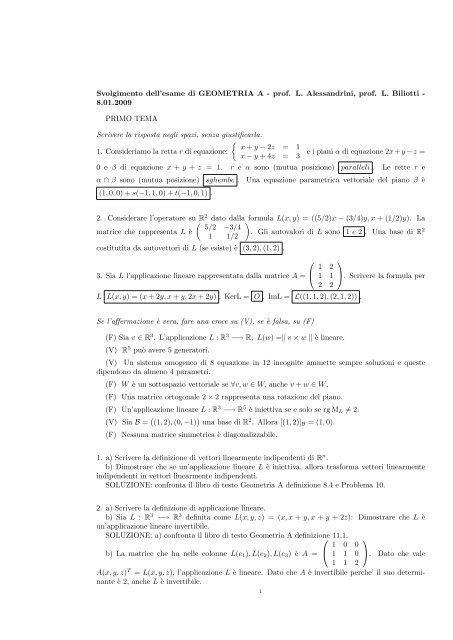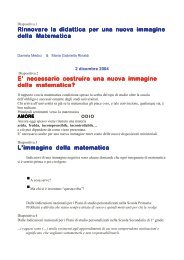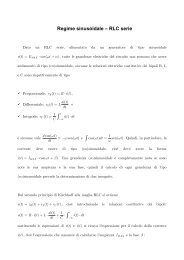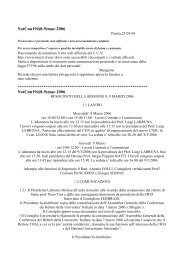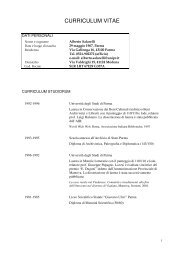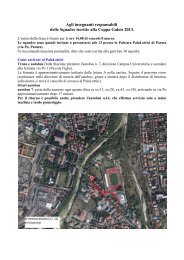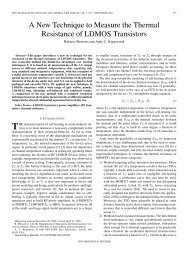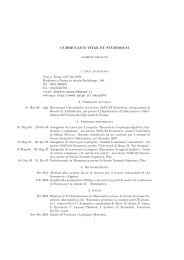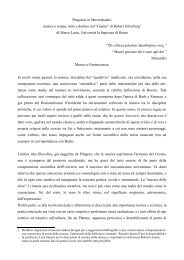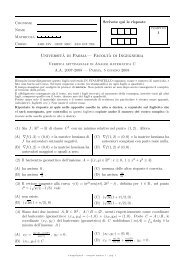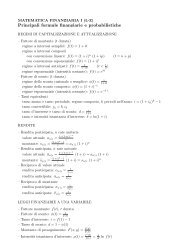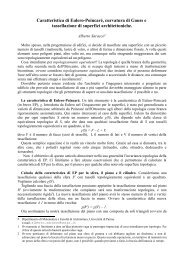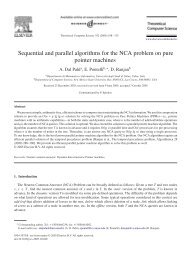Svolgimento dell'esame di GEOMETRIA A - prof. L. Alessandrini ...
Svolgimento dell'esame di GEOMETRIA A - prof. L. Alessandrini ...
Svolgimento dell'esame di GEOMETRIA A - prof. L. Alessandrini ...
- No tags were found...
Create successful ePaper yourself
Turn your PDF publications into a flip-book with our unique Google optimized e-Paper software.
<strong>Svolgimento</strong> dell’esame <strong>di</strong> <strong>GEOMETRIA</strong> A - <strong>prof</strong>. L. <strong>Alessandrini</strong>, <strong>prof</strong>. L. Biliotti -8.01.2009PRIMO TEMAScrivere la risposta negli spazi, senza giustificarla.{ x + y − 2z = 11. Consideriamo la retta r <strong>di</strong> equazione:x − y + 4z = 3e i piani α <strong>di</strong> equazione 2x + y − z =0 e β <strong>di</strong> equazione x + y + z = 1. r e α sono (mutua posizione) paralleli . Le rette r eα ∩ β sono (mutua posizione) sghembe . Una equazione parametrica vettoriale del piano β è(1, 0, 0) + s(−1, 1, 0) + t(−1, 0, 1) .2. Considerare l’operatore su( R 2 dato dalla)formula L(x, y) = ((5/2)x − (3/4)y, x + (1/2)y). La5/2 −3/4matrice che rappresenta L è. Gli autovalori <strong>di</strong> L sono 1 e 2 . Una base <strong>di</strong> R1 1/22costitutita da autovettori <strong>di</strong> L (se esiste) è (3, 2), (1, 2) .3. Sia L l’applicazione lineare rappresentata dalla matrice A = ⎝⎛1 21 12 2L L(x, y) = (x + 2y, x + y, 2x + 2y) . KerL = O . ImL = L((1, 1, 2), (2, 1, 2)) .⎞⎠. Scrivere la formula perSe l’affermazione è vera, fare una croce su (V), se è falsa, su (F)(F) Sia v ∈ R 3 . L’applicazione L : R 3 −→ R, L(w) =‖ v × w ‖ è lineare.(V) R 5 può avere 5 generatori.(V) Un sistema omogeneo <strong>di</strong> 8 equazione in 12 incognite ammette sempre soluzioni e queste<strong>di</strong>pendono da almeno 4 parametri.(F) W è un sottospazio vettoriale se ∀v, w ∈ W, anche v + w ∈ W .(F) Una matrice ortogonale 2 × 2 rappresenta una rotazione del piano.(F) Un’applicazione lineare L : R 3 −→ R 5 è iniettiva se e solo se rg M L ≠ 2.(V) Sia B = ( (1, 2), (0, −1) ) una base <strong>di</strong> R 2 . Allora [(1, 2)] B = (1, 0).(F) Nessuna matrice simmetrica è <strong>di</strong>agonalizzabile.1. a) Scrivere la definizione <strong>di</strong> vettori linearmente in<strong>di</strong>pendenti <strong>di</strong> R n .b) Dimostrare che se un’applicazione lineare L è iniettiva, allora trasforma vettori linearmentein<strong>di</strong>pendenti in vettori linearmente in<strong>di</strong>pendenti.SOLUZIONE: confronta il libro <strong>di</strong> testo Geometria A definizione 8.4 e Problema 10.2. a) Scrivere la definizione <strong>di</strong> applicazione lineare.b) Sia L : R 3 −→ R 3 definita come L(x, y, z) = (x, x + y, x + y + 2z): Dimostrare che L èun’applicazione lineare invertibile.SOLUZIONE: a) confronta il libro <strong>di</strong> testo Geometria A definizione ⎛ 11.1.1 0 0⎞b) La matrice che ha nelle colonne L(e 1 ), L(e 2 ), L(e 3 ) è A = ⎝ 1 1 0 ⎠. Dato che vale1 1 2A(x, y, z) T = L(x, y, z), l’applicazione L è lineare. Dato che A è invertibile perche’ il suo determinanteè 2, anche L è invertibile.1
2SECONDO TEMAScrivere la risposta negli spazi, senza giustificarla.{ x + y + z = 01. Consideriamo la retta r <strong>di</strong> equazione:−y + 2z = 1e i piani α <strong>di</strong> equazione x − y +5z = 1 e β <strong>di</strong> equazione y + z = 1. r e α sono (mutua posizione) parallele . Le rette r eα ∩ β sono (mutua posizione) sghembe . Una equazione parametrica vettoriale del piano β è(0, 1, 0) + s(1, 0, 0) + t(0, −1, 1) .2. Considerare l’operatore ( su)R 2 dato dalla formula L(x, y) = (2x + 3y, −x − 2y). La matrice che2 3rappresenta L è. Gli autovalori <strong>di</strong> L sono 1, −1 . Una base <strong>di</strong> R−1 −22 costitutita daautovettori <strong>di</strong> L (se esiste) è (−3, 1), (1, −1) .3. Sia L l’applicazione lineare rappresentata dalla matrice A = ⎝⎛1 22 11 1L L(x, y) = (x + 2y, 2x + y, x + y) . KerL = O . ImL = L((1, 2, 1), (2, 1, 1)) .⎞⎠. Scrivere la formula perSe l’affermazione è vera, fare una croce su (V), se è falsa, su (F)(V) Sia v ∈ R 3 . L’applicazione L : R 3 −→ R 3 , L(w) = v × w è lineare.(F) Sia A una matrice quadrata e sia S una sua riduzione a scala. Allora det(A) = det(S).(F) Un sistema omogeneo <strong>di</strong> 5 equazione in 9 incognite ammette sempre soluzioni e queste<strong>di</strong>pendono da esattamente 4 parametri.(F) W è un sottospazio vettoriale se ∀v ∈ W, ∀λ ∈ R, si ha anche λv ∈ W .(F) Una matrice ortogonale 2 × 2 ha determinante positivo.(V) Un’applicazione lineare da L : R 5 −→ R 7 è iniettiva se e solo se rg M L = 5.(V) Siano v, w ∈ R 6 linearmente in<strong>di</strong>pendenti. Allora v + w, v − 4w sono vettori linearmentein<strong>di</strong>pendenti.(F) Nessuna matrice simmetrica è <strong>di</strong>agonalizzabile.1. Scrivere la definizione <strong>di</strong> base <strong>di</strong> R n . Sia L : R n −→ R m un’applicazione lineare. Dimostrare chese v 1 , . . . , v n sono una base <strong>di</strong> R n , allora L(v 1 ), . . . , L(v n ) generano ImL.SOLUZIONE: confronta il libro <strong>di</strong> testo Geometria A definizione 8.7 e Problema 10.⎛2. Scrivere la definizione <strong>di</strong> coor<strong>di</strong>nate <strong>di</strong> un vettore rispetto ad una base. Sia B = { ⎝una base <strong>di</strong> R 3 . Calcolare M(B, C), dove C è la base canonica.SOLUZIONE: ⎛a) Confronta il ⎞libro <strong>di</strong> testo Geometria A 8.10.0 1 0b) M(B, C) = ⎝ 1 −1 0 ⎠.−1 0 1111⎞ ⎛⎠ ⎝101⎞ ⎛⎠ ⎝001⎞⎠ }TERZO TEMAScrivere la risposta negli spazi, senza giustificarla.
1. Consideriamo le rette r <strong>di</strong> equazione:{ x + y + z = 1y − 2z = 4 e s <strong>di</strong> equazione { y + 3z = 4x + 2y + 2z = kal variare <strong>di</strong> k ∈ R. I valori <strong>di</strong> k ∈ R (se esistono) per i quali r, s sono complanari sono k = 5 .I vettori <strong>di</strong>rezione delle rette r ed s sono linearmente <strong>di</strong>pendenti? no Completare a base <strong>di</strong> R 3 ivettori <strong>di</strong>rezione <strong>di</strong> r e s (−3, 2, 1), (4, −3, 1), (1, 0, 0) .2. Sia L : R 3 −→ R 4 data da L(x, y, z) = (x + y, 2x + 3y + z, y + z, −2x − 2y). rg(M L ) = 2 .KerL = (x, −x, x) . ImL = L((1, 2, 0, −2), (1, 3, 1, −2)) .3. Sia L l’applicazione lineare rappresentata dalla matrice A = ⎝⎛1 0 −10 1 11 1 0⎞3⎠. Scrivere la formulaper L L(x, y, z) = (x − z, y + z, x + y) . Gli autovalori <strong>di</strong> L sono 0 e 1 . L è <strong>di</strong>agonalizzabile? no .Se l’affermazione è vera, fare una croce su (V), se è falsa, su (F)(V) Siano v, w ∈ R 6 linearmente in<strong>di</strong>pendenti. Allora v + w, v + 4w sono vettori linearmentein<strong>di</strong>pendenti.(F) Una matrice ortogonale 2 × 2 ha determinante non negativo.(V) Un sistema <strong>di</strong> 5 equazione in 9 incognite ammette sempre soluzioni e queste <strong>di</strong>pendono daalmeno 4 parametri.(F) Le coor<strong>di</strong>nate <strong>di</strong> v = (3, 4) rispetto alla base B = ( (1, 2), (−1, −3) ) <strong>di</strong> R 2 sono (2, 2).(F) Sia A una matrice quadrata n × n. Allora rg(A) ≥ n.(V) Un’applicazione lineare L : R 7 −→ R 6 può essere suriettiva.(F) Ogni applicazione lineare L : R 5 −→ R 5 è un isomorfismo.(F) Le matrici <strong>di</strong> rotazioni del piano sono <strong>di</strong>agonalizzabili.⎧⎨1. a) Al variare <strong>di</strong> k ∈ R, <strong>di</strong>re quando il sistema⎩x + y + z = 12x + y − z = 0x − kz = kè risolubile e quando possibilescrivere le soluzioni in funzione <strong>di</strong> k.SOLUZIONE: il sistema è risolubile e ha soluzione unica per k ≠ 2. La soluzione in questo casoè (2 k+1k+12−k− 1, 2 − 32−k , k+12−k ).2. a) Scrivere la definizione <strong>di</strong> autovettore e <strong>di</strong> autovalore <strong>di</strong> un operatore T .b) Sia A una matrice quadrata n × n. Dimostrare che λ ∈ R è un autovalore <strong>di</strong> A se e solo se λè autovalore <strong>di</strong> A T .SOLUZIONE: a) ve<strong>di</strong> testo <strong>di</strong> Geometria A, Definizione 13.3.b) λ è autovalore <strong>di</strong> A ⇐⇒ det(A − λI) = 0 ⇐⇒ det(A − λI) T = 0 ⇐⇒ det(A T − λI) =0 ⇐⇒ λ è autovalore <strong>di</strong> A T .QUARTO TEMAScrivere la risposta negli spazi, senza giustificarla.{ {x + 2y + z = 2y − 3z = 11. Consideriamo le rette r <strong>di</strong> equazione:y + z = 1 e s <strong>di</strong> equazione x + y + z = kal variare <strong>di</strong> k ∈ R. I valori <strong>di</strong> k ∈ R (se esistono) per i quali r, s sono complanari sono k = 1 .
4I vettori <strong>di</strong>rezioni delle rette r ed s sono linearmente <strong>di</strong>pendenti?vettori <strong>di</strong>rezione <strong>di</strong> r e s (1, −1, 1), (−4, 3, 1), (1, 0, 0) .no Completare a base <strong>di</strong> R 3 i2. Sia L : R 3 −→ R 4 data da L(x, y, z) = (x + y + z, 2x + y + 3z, y − z, −2x − 4z). rg(M L ) = 2 .KerL = (−2z, z, z) . ImL = L((1, 2, 0, −2), (1, 1, 1, 0)) .3. Sia L l’applicazione lineare rappresentata dalla matrice A = ⎝<strong>di</strong> L L(x, y, z) = (x + 2z, y + 2z, x + y + z) .Gli autovalori <strong>di</strong> L sono 1, 3, −1 . L è <strong>di</strong>agonalizzabile? si .⎛1 0 20 1 21 1 1⎞⎠. Scrivere la formulaSe l’affermazione è vera, fare una croce su (V), se è falsa, su (F)(F) Se L : R 4 −→ R 4 è un’applicazione lineare, allora Ker 2L = {0}.(V) Un’applicazione lineare L : R 4 −→ R 3 non può essere iniettiva.(V) Un sistema omogeneo <strong>di</strong> 5 equazione in 13 incognite ammette sempre soluzioni e queste<strong>di</strong>pendono da almeno 8 parametri.(F) W è un sottospazio vettoriale se ∀v, w ∈ W, vale v − 2w ∈ W .(F) Se L : R n −→ R m è un’applicazione lineare invertibile, allora m < n.(V) Se A ∈ M n×m allora rgA ≤ n e rgA ≤ m.(V) Siano v, w ∈ R 6 linearmente in<strong>di</strong>pendenti. Allora v + w, v sono vettori linearmente in<strong>di</strong>pendenti.(V) Una matrice <strong>di</strong> cambiamento <strong>di</strong> base è invertibile.1. a) Al variare <strong>di</strong> k ∈ R⎧⎨⎩x + z = 0x + y + z = 12x − kz = k + 1<strong>di</strong>re per quali valori <strong>di</strong> k ∈ R il sistema èrisolubile e quando possibile scrivere le soluzioni in funzione <strong>di</strong> k.SOLUZIONE: il sistema è risolubile e ha soluzione unica per k ≠ −2. La soluzione in questo casoè ( k+1 k+12+k, 1, −2+k ).2. a) Scrivere la definizione <strong>di</strong> autovettore e <strong>di</strong> autovalore <strong>di</strong> un operatore T .b) Sia A una matrice quadrata n × n. Dimostrare che λ ∈ R è un autovalore <strong>di</strong> A allora λ 2 èautovalore <strong>di</strong> A 2 .SOLUZIONE: a) ve<strong>di</strong> testo <strong>di</strong> Geometria A, Definizione 13.3.b) Se λ è autovalore <strong>di</strong> A allora esiste v ≠ O con Av = λv e dunque A(A(v)) = A(λv) = λ(Av) =λ 2 v.


